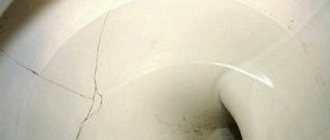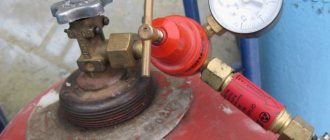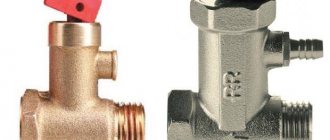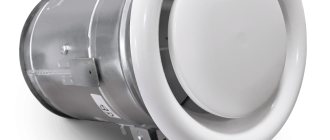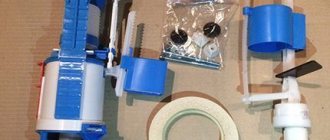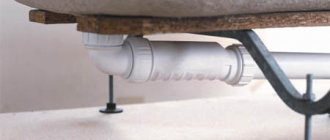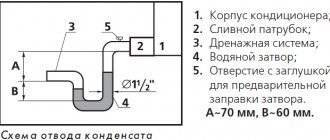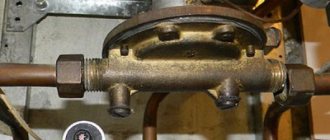Europeans are amazingly creative when it comes to saving money. One of these devices is a bottom valve, which allows you to use much less water and not overpay your utility providers. The product has an ingeniously simple design, and at the same time it is very practical and easy to use.
Although the device first appeared in England, our compatriots also highly appreciated it and are using it more and more often.
We suggest you understand the design and operating principle of plugs, their advantages and disadvantages. The answers to the above questions are described in detail in the article. In addition, we have provided tips on choosing a foot valve and prepared step-by-step instructions for installing it.
Convenient savings with bottom valve
These are small shut-off devices that are installed in sink drains to retain water. They were originally intended for water supply systems in which hot and cold water are drawn from different taps. This is how bathrooms are equipped in some European countries.
In our country, this function is performed by different types of faucets, so shut-off valves for sinks have found other uses. They are used if you need to wash, shave, or manually wash children's clothes or underwear.
The devices eliminate the need to pour running water or collect it in a basin. Simply lower the valve and the sink will be filled in literally a minute.
For the device to work, you need to press the lid. The spring of the mechanism will open and move the plug blocking the sink drain hole
There are two main types of valves:
- With mixer . Devices included. Their installation is provided for by the model of the plumbing fixture. To control the operation of such a bottom valve, a small lever is used, which is located behind the tap or on the side of it.
- Push Open . These models are sold separately from the faucets. They are less popular than devices of the first type. They are often bought by people who are already accustomed to using a locking product, but the old one has worn out and needs to be replaced.
The devices would hardly have found widespread use in the post-Soviet space if they had not been included in some faucet models. Quite quickly, the benefits of their use became obvious, and now shut-off valves for sinks are in demand among buyers.
Another plus: installation does not require any fundamental changes to the water supply or sewerage systems.
Most of the design details are located under the sink: the connecting rod, the threaded connection and the siphon. They are not conspicuous and do not spoil the interior
Designs can be with or without overflow. Externally they differ little, but the difference in functions is noticeable.
Valves of the first type are safe: if the water pressure suddenly increases or the owner moves away for a minute, the excess liquid will drain into the drain and not onto the floor.
It is better to purchase a model with an overflow. This will protect the bathroom from flooding if the valve wears out and stops performing its functions.
If the device does not have an overflow, the slightest carelessness can result in trouble.
What it is?
The bottom valve in faucets is a design that serves to block the hole at the bottom of the sink if you need to draw a certain amount of water into it. Abroad, the issue of water consumption is quite acute, so people are accustomed to using this resource sparingly, and the bottom valve is exactly the device that can help with this. It is a more reliable option than plastic and rubber plugs, which often fail and wear out quickly when used.
A simple device is mounted at the bottom of the washbasin , in its drain hole and, if necessary, closes the pipe connecting to the water supply. At the same time, a regular faucet with two valves is installed that regulates cold and hot water.
Design and principle of operation
Lever (automatic) models consist of several functional elements:
- Cork . This is the valve that closes the drain hole in the sink.
- lever (spoke). It is used to raise and lower the cork. This is convenient - you don’t have to put your hand in a sink filled with water.
- Rod . It connects the control lever and the plug.
- Carving . The device is screwed to the siphon using a threaded connection.
- Siphon . The entire assembly is an integral structure for controlling water drainage.
Push Open valves are push-type mechanisms in which the plug is controlled by a spring.
The design is simpler than a lever one, but less convenient to use. To press the plug, you have to put your hand in the water. Many people find this unpleasant, especially if they washed or washed dirty clothes in the sink.
Click-clack system models are very compact and beautiful. Some designer valves are true works of art, but are also quite functional.
A significant advantage of Push Open models is their aesthetic appearance. A compact stopper at the bottom of the sink looks much more attractive than a complex design with a lever. From the outside, only a round lid is visible, the color of brass, bronze or chrome.
Kinds
The headset is classified based on the specifics of the drain and the basic configuration.
The following types of products are distinguished:
- mechanical products;
- automatic devices.
The first type is sometimes called spring, due to its presence in the structure. This push mechanism ensures complete blocking of the water drainage, and pressing again, on the contrary, releases the outlet for liquid.
Mechanical bottom valves have positive characteristics:
- simple installation;
- long service life;
- low cost.
Along with the advantages, bottom valves of this category have some disadvantages, namely: you can drain the water only by pressing the device regulator, which is the lid itself. Which requires immersing your hand in water that may already be quite contaminated, such as after washing dishes in the kitchen sink. This will require additional cleaning of the hand when using water, which will negatively affect savings.
Automatic devices do not have such a negative property, due to the peculiarities of regulating its operation. It is always possible to release water by using a lever or other control element with which the valve is equipped.
The mechanical part consists of metal pins:
- a lever that drains the liquid;
- connecting needle;
- base for attaching the plug to the pipe;
- cork.
The presence of such a design in a sink or washstand does not in any way affect the aesthetic component of the plumbing fixtures or the overall interior of the room, since the machine itself is located directly under the bowl. The adjustment lever is included in the standard equipment of the device, so installing it will not be difficult even for the average person; just follow the supplied instructions. Today, many manufacturers offer semi-automatic models to consumers.
There are also varieties of these devices that have a special mechanism that provides control of the filling level of the container. It works in a similar way to a bathroom drain pipe. This feature allows us to distinguish two types of valves - with and without overflow.
The first type is in demand due to the presence of a similar insurance characteristic. It is relevant in unusual cases, when you forgot to turn off the water or a child used the sink. Excess liquid is discharged through a special tube. It drains the water into the drain.
Devices without overflow are usually purchased for sink models whose configuration does not allow the installation of a bottom valve with the installation of an additional pipe for draining water.
In bathrooms, it is better to give preference to mechanical devices; they are durable and easy to maintain. These types of valves will be an ideal option for daily use, where the format of use itself is somewhat different from work performed in a kitchen sink.
For kitchens, it would be more correct to install an automatic type bottom valve, since the accumulated water in the sink will be dirtier, containing food waste. It will be much more convenient to drain the water using a special lever that is not in the water. Installing a bottom valve at your dacha will make it possible to save on paying for consumed water.
Pros and cons of using a valve
The use of new hydraulic locking devices has several advantages.
- Economic benefit . Due to rising utility tariffs, many had to think about cutting costs. The cost of devices ranges from 500-2000 rubles, depending on the model and manufacturer. It's a small price to pay to reduce bill amounts.
- Easy to use . The valve is operated with one finger. No effort is required to lower or raise it. This is accessible even to children.
- Ergonomic shape . The device is convenient and easy to clean.
- Beautiful design . A neat metal or ceramic lid looks much nicer than a hole in the sink. It also wins in comparison with the usual plastic stopper.
- Reliable fastening . Traditional bathtub and sink plugs are tied to plumbing fixtures using fishing line, which can break at any time. Metal chains improve the situation somewhat, but they are also not entirely reliable, and they also make noise when used.
- Odor protection . Unpleasant odors in the bathroom are not always the fault of the users, and cleaning does not eliminate them.
It can be difficult to deal with the stench, but it is necessary, because sewer gases contain substances hazardous to health - hydrogen sulfide, ammonia. By plugging the drain, you can simply get rid of the problem.
Bottom plugs have no serious disadvantages, but a couple of nuances are worth considering. It will take time to get used to the peculiarities of using the mechanism: you need to monitor the water level when filling the sink.
Design can play a determining role when purchasing plumbing fixtures. Click-clack system models can be selected by style and color
There are also irritating moments in the use of spring mechanisms - putting your hand in dirty, too hot or cold water. And with lever ones, it’s inconvenient to clean the parts located under the sink and behind the mixer.
How to choose?
Different design options are suitable for specific needs. It all depends on where the foot valve is needed. If it is required for a shower tray or bathtub, then it is preferable to choose a mechanical model. It is possible to purchase the device complete with a siphon or separately.
For sinks used for washing, a set with a factory-made automatic valve is suitable; such equipment is also available for bidets. When purchasing a faucet and valve separately, you can opt for models with a chrome finish; this combination will be optimal.
The main criteria to be guided by:
- quality of the locking system, lever or mechanical;
- device for overflow (its presence or absence);
- aesthetics of appearance;
- product manufacturing company.
By the way, almost all these nuances affect the cost of the design. Of course, the most important thing is high quality and durability, which is why such equipment is chosen only from trusted manufacturers. As a rule, this means a high degree of tightness, immunity of parts to the aggressive effects of hot water and the salts it contains.
Any product of this type must have a quality certificate and other important documentation that you need to familiarize yourself with. In case of any breakdown within the specified period, the device can be replaced thanks to the warranty card.
The bottom valve is a functional accessory that helps make water consumption more economical and is easy to use, and thanks to the instructions, you can do the installation yourself.
Safety valve: operating principle and types How to strengthen the foundation of a wooden house? Warm floor ensto Three-way valve How to strengthen the foundation of a brick house? What color should I paint the gable of my house?
By what criteria are plugs selected?
First of all, you should decide on the price. You need to understand well what the buyer gets for his money - quality of materials and workmanship, design or additional convenience.
An important selection criterion is the quality of the metal and threaded connection. To understand how reliable the chosen model is, you need to make sure of the strength of the material. It is advisable to check how the plug is assembled and disassembled
Let's consider several design features on which the price depends:
- presence of overflow;
- type of control;
- design;
- brand.
The model should be selected based on the type of sink. If it does not provide for the possibility of removing excess water, install a bottom valve without overflow. An option is to replace the siphon with a more practical one.
As for the management mechanism, you need to clearly define your goals. If the sink holds water for hand washing, it is unlikely to be too dirty after use. There will be no problems with lowering your hand to the spring valve.
But if you plan to wash dirty shoes or greasy objects, it is better to give in to natural disgust and buy a lever device.
The design affects the cost of the product. Taking into account the range of prices, the overpayment for a beautiful design of the bottom valve is not that great. Therefore, you should not deny yourself the pleasure of putting a beautiful plug on the sink
The role of the brand is difficult to overestimate when choosing fittings. Brand reputation is not only advertising, but also an indicator of the real quality of goods. Before purchasing, it is advisable to read user reviews and take into account their complaints about different manufacturers.
The bottom shut-off valve is a small part, but it can cause unpleasant moments if it quickly fails. It’s better to pay a couple of hundred rubles more and buy a reliable, beautiful plug that will last for several years without breaking.
Operational problems
Like any plumbing fixture, a mixer with the ability to switch to a shower head has its own service life. A common problem that homeowners face during operation is dripping faucets. Knowing what the mixer consists of, you can fix the leak yourself and extend the life of the equipment. The most common causes of leakage are:
- Ball mechanism or cartridge clogged. Due to the poor quality of tap water, the insides of the faucet often become clogged. This causes the mechanism responsible for mixing water to fail. You can fix this problem by cleaning or replacing the cartridge.
- Abrasion of gaskets. Due to constant friction when turning the tap or control knobs, the sealing gaskets gradually wear out and cease to perform their intended functions. Replacing the gaskets solves this problem.
- Changing the position of the spool mechanism. If the screws securing the spool become loose, it can change its position in space. Because of this, the shower switch may leak. To fix this damage, you need to tighten the screws and adjust the spool.
Detailed installation instructions
The bottom valve, which is included with the mixer, is installed in stages. To install it, you will need simple tools and plumbing sealant, which is used to seal seams when installing plumbing fixtures. All work can be done independently.
The only caveat: the standard set contains all the tools with sharp edges that can damage the sink coating. It is advisable to prepare gaskets in advance and press metal elements through them to protect the plumbing.
Stage 1 – preparatory work
The lever and hoses lead down through the hole, under the sink. Typically, mixers are equipped with flexible tubes. If the model comes with rigid hoses, you will have to bend them yourself.
It is important to do the work very carefully so as not to damage the walls of the pipes, otherwise they will quickly rot and leak.
It is highly undesirable to file the products, because... chips can easily get into the faucet mechanism. During operation, problems will arise that will lead to premature abrasion and wear of parts.
If it is impossible to do without cutting the hard pipes, after finishing the work you need to thoroughly rinse all structural elements with a powerful stream of running water.
To ensure that the faucet is securely attached to the sink, it is placed on a sealant. You should choose a moisture-resistant composition with antiseptics (sanitary) to prevent the appearance of fungus and mold
The tap is secured with a clamping nut. If there are doubts about the reliability of the installation, you can use sealant as an additional method of fixation.
Stage 2 - assembly and connection of parts
Using nuts with rubber gaskets, the hoses are connected to the supply pipes. You need to follow the shape of the bend. If it turns out to be in the shape of the letter U, everything is fine: water will flow freely.
But an S-shaped bend is undesirable. Unnecessary obstacles will create conditions for an uneven increase in pressure in the system, which within a year or two will lead to leaks at the joints.
Any model should include a plastic connector for the spokes. When purchasing a valve, you should ensure that the part is available. If you have to buy it separately, it may be difficult to select sizes
The shut-off valve is placed in the sink drain hole and the spokes are assembled. They are laid crosswise using a special plastic connector.
The clamp itself is twisted with a screwdriver. The result is a simple but reliable cross-shaped design.
Stage 3 - installation of the lever and siphon
The spoke must be connected to the lever and attached to the eye of the device, as shown in the diagram below.
After completing this work, you should immediately make sure that when moving up and down, the lever easily raises and lowers the spoke. Sometimes you have to adjust the mount (+)
All that remains is to bring the corrugation from below and secure the siphon. It is important that the plug tightly closes the drain hole, so immediately check the quality of the system’s assembly.
It is necessary to open the tap and observe how the plumbing works for 3-5 minutes.
A sink with a bottom valve but without an overflow hole can be improved. To do this, simply buy and install the correct siphon (+)
If the water flows well into the drain and the joints remain dry, everything is in order. If signs of leakage appear, the nuts should be tightened.
If even after this the joints are wet, you will have to completely disassemble the system and redo the work, since the installation was clearly done incorrectly. Sealing tape can correct the situation, but it is unlikely to last long.
Stage 4 - checking the tightness of the plug
The work can be considered complete if the siphon does not leak and the shut-off valve tightly closes the drain hole. They check it like this: lower the plug, draw the maximum amount of water into the sink and leave it for half an hour to an hour.
A leaking plug won't do much good. If water quickly leaves the sink into the sewer, it is better to redo the work - disassemble the valve and reassemble it
The indicator of correct operation of the device is a constant level. It’s better not to rely on your own eye and make a mark on the sink with a marker.
If after an hour the water remains at the same level, the shut-off valve is installed perfectly. Minor changes are a reason to check the tightness of the lid to the bottom of the sink.
DIY installation of a valve on a sink
After purchasing such a product, you should immediately install it in the drain to evaluate the convenience and savings. This can be done in a small amount of time alone.
NOTE. Before you start installing the bottom valve on the sink with your own hands, you need to pay attention to the fact that the tools mainly used in the work have sharp surfaces
which can easily damage the ceramic base of the sink. Therefore, the best option is to use equipment with special jaws or without sharp teeth. You can also use conventional devices, but then you need to place gaskets on the surface of the sink itself (cardboard or metal).
The sequence of actions should be something like this:
- The lever with which the drain will be adjusted, as well as the hoses that come from the mixer, are placed in the lower hole. In this case, you can glue the faucet to the sink using sealant so that it fits securely into the hole.
IMPORTANT. It happens that bottom valves intended for installation on a sink are supplied not with soft, but with hard tubes
In this case, they will need to be bent manually to give the desired shape. It is not advisable to trim the tubes because metal filings (shavings) often get into the faucet mechanism itself, making it difficult to move it around. Therefore, if you decide to trim the pipes, you must rinse all internal surfaces with a strong stream of water for 3-5 minutes in all directions.
- Next, the body itself is mounted on the sink using a nut. There must be rubber gaskets between the body and the sink on both sides (usually they are included in the kit).
- After this, the hoses are connected to the hot and cold water pipes, respectively. Again, all seats are accompanied by spacers on both sides.
IMPORTANT. It should be taken into account that the pipes can be longer and be bent in an arc (U-shaped bend). However, zigzag (S-shaped) bends are not allowed. The fact is that in this case, the water pressure on the internal surfaces of the pipes will be uneven, as a result of which they will wear out much faster (they can leak within a year if they are used frequently in this condition).
A water seal (bottle or tubular siphon) is placed in the drain, and the valve spokes are folded into the shape of an equilateral cross. To create a rigid structure, they are secured with a self-tapping screw in a cross-shaped form made of plastic.
The ends of the spokes are connected according to the scheme: with a lever on one side and with a valve loop on the other. Thus. vertical translational movements will provide a future mechanism for draining water when the lever is pressed.
Next, a siphon and a pipe leading to the sewer are connected to the drain as usual.
VALUABLE ADVICE. Before starting work, be sure to check the system to see how well it is assembled. A sink valve usually requires precise installation into the drain, as it subsequently creates a complete plug for water. If, after passing large volumes of water, even a small leak is detected, the system needs to be rebuilt. First, just tighten all the threaded connections tighter. If this measure did not eliminate the leakage, then... There were some significant errors in the installation, and the work needs to be done again.
The bottom valve for the sink can be installed as an additional accessory on a ready-made system. It often happens that it is mounted immediately with the mixer.
Video instructions for installing the bottom valve
The general assembly diagram along with an approximate drawing is shown in the figure below.
Sinks with overflow
In the case where the bottom valve is already installed in the drain hole, but it does not have an overflow system, you can go the other way and purchase a siphon with an overflow, which is also easy to assemble yourself. Technically, an overflow is a tube made of any material (lately plastic is more often used), with the help of which excess water leaves the sink when the bottom valve is closed. The assembled device is shown in the figure.
A sink with an overflow is distinguished by the fact that 2 pipes go simultaneously to its siphon - 1 directly from the drain hole (a valve is built into it), and the other from the upper drain pipe, which ensures that water does not overflow.
Design
The design of the bottom valves is not very diverse. Most of the product is hidden; only one element remains visible - a round metal cap. Since the drain hole is always round, the bottom valve covers are almost always round in shape. Although sometimes you can find designer products with unusual lid shapes. The most significant way the models may differ is in the color of the coating. The bottom valve included with the mixer will have a coating identical to the mixer. If you purchase the faucet and valve separately, it is better to opt for a standard chrome finish. You will have to look for a bottom valve in some other color option - 90% of all models are available in chrome.
Pallet
It can either be placed on the bottom of the bowl or rest on its edges. A tray looks like a shallow tray, often with holes. This device is convenient for defrosting meat and fish and drying vegetables, and will be especially useful for sinks without a wing.
Push Open System
Less common valves are Push Open. Their main disadvantage is that to open the drain hole you must manually operate the valve, that is, wet your hand. But such a valve is installed quite quickly and is much easier to maintain.
It is also used for baths and bidets.
This type of sink set, like a bottom valve, began to appear in our apartments quite recently, so not many people know about it. However, it is becoming more and more popular in our country. Next, we will look at the convenience of this design and how to install it on the sink.
Care
It is important not only to install the siphon correctly, but also not to forget to care for it. For example, the main reason for the rapid wear of equipment is constantly dripping water. Therefore, it is important to check the tightness of the closed tap and, if necessary, replace the device.
The siphon must be periodically cleaned of layers of dirt and limescale. Kitchen siphons, as you know, are more likely to become clogged with food debris, so their cleanliness must be monitored especially carefully.
Light dirt can be removed with a plunger or chemicals like Mole. However, you should not use “chemistry” often. It negatively affects the condition of plumbing fixtures. You should not remove the top grill from the sink, as it protects the siphon from debris. To remove minor dirt and odors, it is recommended to occasionally flush the sink drain with hot water.
If the siphon itself is leaking under the kitchen sink, replacing the gasket may be enough. You can contact a plumber for this service, or you can do the work yourself. Simply remove the old part and install the new one. If necessary, use special plumbing tape. Fum tape seals leaks well and eliminates the use of silicone or sealing glue.
Traditional methods can help eliminate odors coming from the sewer system. For example, it may be enough to pour salt into the sink and flush the system. Less dirt is retained in smooth pipes. The corrugated inner surface accumulates more debris, which gives off an unpleasant odor.
Regularly inspect the rubber gaskets and parts of the siphon connected to each other with nuts.
It is better to replace shrunken and outdated rubber parts as soon as a change in the appearance of the parts becomes noticeable. With outdated connections, the “bottle” or “flask” can fall off at any time. In the event of an accident, you will have to repair not only the siphon, but also household appliances, if they were connected to the system.
To learn how to properly assemble a siphon for a sink with overflow, see the following video.
Summarizing
At first glance, unnecessary devices for bathtubs, showers or sinks can actually be irreplaceable. Providing comfort, they instantly become design elements and create a calm atmosphere. And the practical use of such innovations as, for example, the bottom valve, will expand as we get used to the European “thing.” Because while in Europe people are economical, in the Russian Federation they are creative.
Any theory must be supported by action, and the video in this article can become a practical guide for you on installing a foot valve.
Overflow of water
There are several reasons why water from the sink begins to overflow:
- The drain hole is closed intentionally to fill the sink with water; the tap opens, but for some reason does not close again.
- Accidental blockage or blockage of the drain hole.
USEFUL INFORMATION: Design and types of siphon for the sink
In such a situation, the drain-overflow system for the sink comes into play. Having reached a certain level, the liquid begins to flow out through a special technical hole, and through it, through the drain tube, it enters directly into the siphon reservoir and continues its path, as expected, into the bowels of the sewer system.
